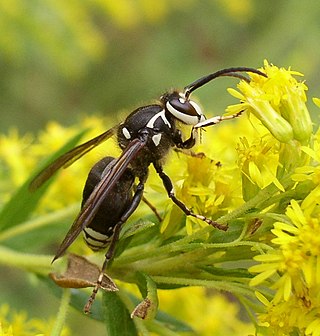
The Mutillidae are a family of more than 7,000 species of wasps whose wingless females resemble large, hairy ants. Their common name velvet ant refers to their resemblance to an ant, and their dense pile of hair, which most often is bright scarlet or orange, but may also be black, white, silver, or gold. Their bright colors serve as aposematic signals. They are known for their extremely painful stings,, and has resulted in the common name "cow killer" or "cow ant" being applied to the species Dasymutilla occidentalis. However, mutillids are not aggressive and sting only in defense. In addition, the actual toxicity of their venom is much lower than that of honey bees or harvester ants. Unlike true ants, they are solitary, and lack complex social systems.

Vespoidea is a superfamily of wasps in the order Hymenoptera, although older taxonomic schemes may vary in this categorization, particularly in whether to recognize the superfamilies Scolioidea or Formicoidea. Vespoidea includes wasps with a large variety of lifestyles: eusocial, social, and solitary habits, predators, scavengers, parasitoids, and some herbivores.

The Tiphiidae are a family of large, solitary wasps whose larvae are parasitoids of various beetle larvae, especially those in the superfamily Scarabaeoidea. Until recently, this family contained several additional subfamilies, but multiple studies have independently confirmed that these comprise a separate lineage, and are now classified in the family Thynnidae.
The International Society for Phylogenetic Nomenclature was established to encourage and facilitate the development and use of, and communication about, phylogenetic nomenclature. It organizes periodic scientific meetings and is overseeing the completion and implementation of the PhyloCode.
Saperion is an extinct genus of trilobite-like arthropod. It lived during the late Atdabanian stage, which lasted from 521 to 514 million years ago during the early part of the Cambrian Period. It was found in the Maotianshan Shales Saperion reached 151 mm in length and had nearly 25 pairs of limbs for walking.

The Bradynobaenidae are a family of wasps similar to the Mutillidae, differing most visibly in the presence, in females, of a suture separating the pronotum from the mesonotum. These species are often found in arid regions. Recent classifications remove two of the five constituent genera, both from the New World, to a separate family Chyphotidae, thus restricting true bradynobaenids to the Old World.
Inanidrilus fijiensis is a species of annelid worm.
Inanidrilus is a genus of marine annelid worms, first described by Christer Erséus in 1979. They are gutless and live in the interstitial of tropical and subtropical seas.
Antygomonas incomitata is a species of kinorhycha. This particular species was found in the Bay of Vestar.

Cavernicola is a suborder of planarians found mostly in freshwater habitats of caves, although some species occur on the surface.
Coralliodrilus rugosus is a species of clitellate oligochaete worm, first found in Belize, on the Caribbean side of Central America. It is found in a range of sediments near the limits of saline groundwater, but never below tidal zones.
Thalassodrilides bruneti is a species of oligochaete worm, first found in Belize, on the Caribbean side of Central America.
Limnodriloides adversus is a species of clitellate oligochaete worm, first found in Belize, on the Caribbean side of Central America.

The Thynnidae are a family of large, solitary wasps whose larvae are almost universally parasitoids of various beetle larvae, especially those in the superfamily Scarabaeoidea. Until recently, the constituents of this family were classified in the family Tiphiidae, but multiple studies have independently confirmed that thynnids are a separate lineage.

The Chyphotidae are a family of wasps similar to the Mutillidae, differing most visibly in the presence, in females, of a suture separating the pronotum from the mesonotum. These species are found primarily in arid regions in the southwestern United States and adjacent regions in Mexico.

The Myrmosidae are a small family of wasps very similar to the Mutillidae. As in mutillids, females are flightless, and are kleptoparasites in the nests of fossorial bees and wasps.

Rhabdocoela is an order of flatworms in the class Rhabditophora with about 1700 species described worldwide. The order was first described in 1831 by Christian Gottfried Ehrenberg. Most of rhabdocoels are free-living organisms, but some live symbiotically with other animals.
Fecampiida is an order of flatworms in the class Rhabditophora. It is a considerably recent clade, erected after molecular studies.

Myzinum is a genus of wasps in the family Thynnidae. There are 63 species presently recognized in Myzinum. They measure 7–24 mm. They are found in meadows, fields, and lawns. They parasitize white grubs, including Phyllophaga. They are used as biological controls.

Tiphioidea is a suggested superfamily of stinging wasps in the order Hymenoptera. There are three families in Tiphioidea, Bradynobaenidae, Tiphiidae, and Sierolomorphidae.












